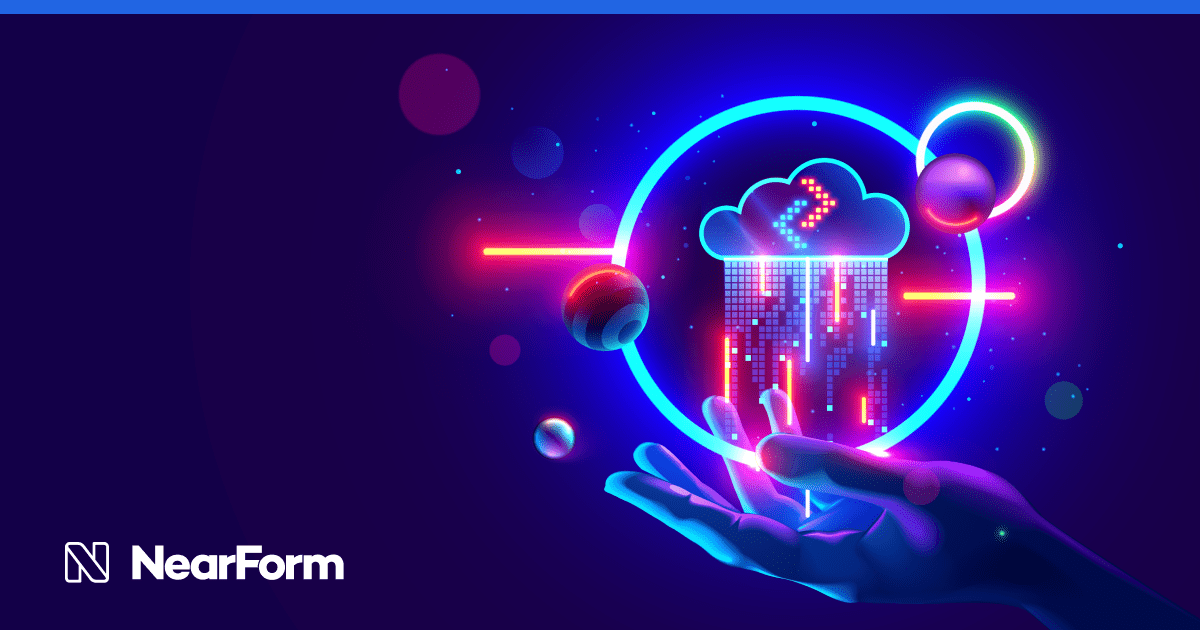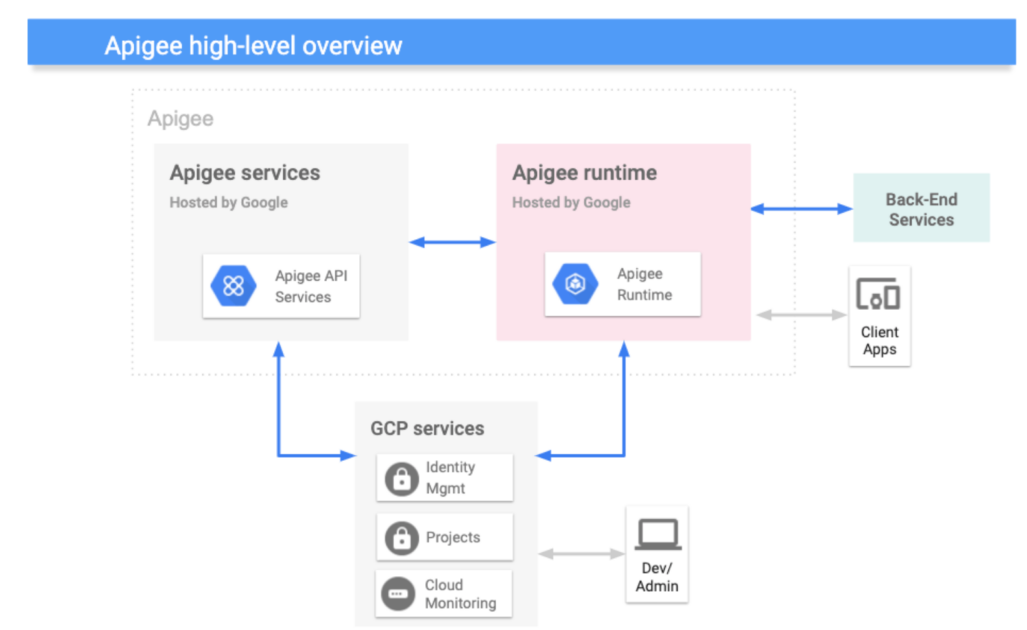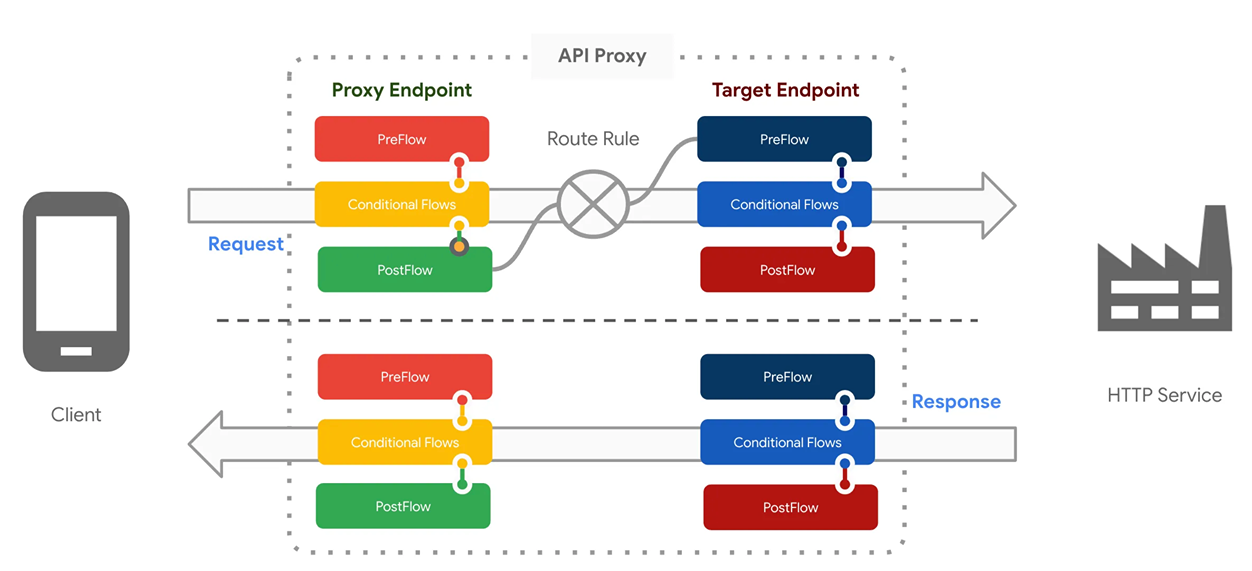How to Get Started with Google Apigee X
 Nearform
Nearform
By Kenan Dervisevic
Google Apigee X is a comprehensive, full-lifecycle API management solution that empowers businesses to accelerate growth by unlocking the value of data and delivering modern applications.
Apigee X integrates Google’s artificial intelligence (AI), security and networking capabilities to help enterprises better manage the complexities of their digital transformation journey.
This article provides an overview of Apigee X and outlines how you could implement it within your organization.
What is the Apigee API platform?
Apigee is a full-featured API (Application Programming Interface) management platform that provides tools and services to help organizations design, deploy, monitor, and secure APIs. It’s part of Google Cloud, and it differentiates itself from other services, both within the Google Cloud platform and from competitors in other cloud vendors, through several key features.
Apigee offers a comprehensive suite of tools to cover the entire API lifecycle, including API design, development, deployment, analytics, and security. This end-to-end approach is important for managing APIs effectively.
Apigee provides analytics capabilities, allowing you to monitor API usage, track performance, and gain insights into how your APIs are being used. This data-driven approach helps in making informed decisions and optimizations.
A customizable developer portal that enables API publishers to create a self-service experience for developers who want to consume the APIs is also a part of this solution. This portal provides documentation, code samples, API key management, and interactive features to engage developers.
Apigee includes features for API monetization, allowing organizations to create new revenue streams by offering APIs as products that can be subscribed to by external developers or partners. As part of Google Cloud, Apigee offers seamless integration with other Google services such as Cloud Functions, Cloud Run, BigQuery, and more. This makes it easier to build and deploy comprehensive solutions.
What is Google Apigee X?
The Google Apigee X platform enables developers to design, secure, analyze, and scale APIs anywhere with visibility and control. Furthermore, it integrates Google Cloud’s AI, security, and networking features to ensure the reliability, robustness, and intelligence of the APIs.
Apigee X offers the capability to establish a secure pathway for accessing your services through a well-defined API that remains uniform across all your services, irrespective of their underlying implementations.
Instead of having application developers directly consume your services, they interact with an API proxy constructed on Apigee’s platform. This API proxy serves as a bridge between a publicly accessible HTTP endpoint and your backend service.
The creation of this API proxy delegates security and authorization responsibilities to Apigee, along with the analysis and monitoring of the services. As developers send their HTTP requests to the API proxy rather than directly to your services, they are shielded from the specifics of your service implementation.
The API proxy effectively isolates app developers from the intricacies of your backend service. This separation empowers you to modify the service implementation while maintaining a consistent public API. This flexibility extends to alterations like changing database backends, relocating services to new hosts, or implementing other service-level changes. By preserving a stable frontend API, any pre-existing client applications can remain functional despite any modifications made on the backend.
Core features of Apigee X
Apigee X is the latest variant released by Google. Like Apigee Edge, in Apigee X, both the management plane and the runtime are managed by GCP (Google Cloud Platform). The Apigee runtime resides in your VPC Network, and a GCP HTTP(s) load balancer is used as the entry point into Apigee.
These are the key features of Apigee X:
AI-powered API management
Apigee X harnesses Google’s machine learning (ML) capabilities to provide predictive analytics, allowing users to anticipate traffic spikes and anomalies. It also offers insights and recommendations, which can help with API optimizations.
Global scale and performance
Apigee X integrates with Google’s global network, enabling organizations to deploy their APIs globally for optimal performance and scalability.
Enhanced security
Apigee X provides industry-leading security capabilities, including Google Cloud Armor integration for API threat protection, Cloud Identity and Access Management (IAM) for granular control, and data loss prevention tools.
Unified and extensible platform
Apigee X is built on a platform that is consistent, extensible, and integrates seamlessly with Google Cloud. This provides the agility to add or change API-driven strategies as per business needs.
Comparison to Amazon API Gateway (AWS)
Amazon API Gateway is a fully managed service that simplifies the process of creating, managing, securing, and monitoring APIs at scale. It supports both RESTful and WebSocket APIs.
Choosing between Apigee and AWS API Gateway depends on your specific needs:
Apigee might be better if:
You need comprehensive API management with advanced analytics and developer engagement.
Your organization is invested in the Google Cloud ecosystem.
You require hybrid or multi-cloud deployment support.
Monetization features are essential for your business model.
AWS API gateway might be better if:
Your infrastructure is heavily based on AWS services.
You’re focused on serverless architecture and seamless integration with AWS Lambda.
You need efficient caching, throttling, and usage controls.
Your use case involves WebSockets and real-time communication.
Ultimately, the “better” choice depends on your priorities and the technical and business requirements of your project. It’s recommended to thoroughly evaluate both solutions based on your specific criteria before making a decision.
Comparison to Azure API Management (Microsoft)
Azure API Management is a scalable, multi-cloud API management platform that allows users to create, publish, maintain, monitor, and secure APIs.
Comparative Points with Apigee X:
Azure API Management, like Amazon API Gateway, offers deep integration with its own cloud ecosystem (Microsoft Azure), but Apigee X stands out with its global deployment capabilities and AI-driven insights.
Azure API Management has robust features, but Apigee X offers more extensive capabilities when it comes to bridging legacy systems with modern applications, enabling businesses to modernize at their own pace.
Although Azure API Management provides a solid API management platform, Apigee X’s security features, including Google Cloud Armor integration and granular control through Cloud Identity and Access Management (IAM), offer a more secure environment for managing APIs.
Request/response flow overview
The request/response flow is the fundamental process through which applications communicate and exchange data over the internet using APIs (Application Programming Interfaces). APIs act as intermediaries that allow different software systems to interact with each other. This interaction involves a series of steps that ensure data is transmitted accurately and securely.
1. Request phase:
Client sends a request: The process begins when a client application (also known as a consumer) sends a request to an API. This request typically includes information about the desired action (GET, POST, PUT, DELETE), endpoint, headers, parameters, and sometimes a request body containing data.
API gateway receives the request: The API gateway, like Google Apigee X, serves as a central entry point for API requests. It’s responsible for routing the request to the appropriate backend service.
2. Backend processing:
API gateway forwards the request: The API gateway forwards the request to the backend service responsible for fulfilling the request. This could be a web server, microservice, database, or another service.
Backend service processes the request: The backend service processes the request, performing the necessary actions based on the data provided. It may retrieve, manipulate, or store data.
3. Response phase:
Backend service generates a response: Once the backend service completes its processing, it generates a response. This response typically includes a status code, headers, and a response body containing data or results.
Response Sent to API Gateway: The backend service sends the response back to the API gateway.
4. Client receives response:
API gateway sends response to client: The API gateway receives the response from the backend service and forwards it to the client application that initiated the request.
Client Processes the Response: The client application receives the response and extracts the relevant data. Depending on the response, the client might display information, execute further actions, or make subsequent requests.
Google Apigee X’s role
Apigee acts as a middleware layer between clients and backend services, providing a range of functionalities including:
Routing
Security
Traffic management
Analytics
Response transformation
It ensures that API interactions are secure, optimized, and well-managed while also providing valuable insights into API usage and performance.
Customization with Apigee X
One of the standout features of Apigee X is its ability to customize the request/response flow using policies. Policies are rules that developers can apply to requests and responses to modify, enrich, or secure the data. These policies include modifying headers, transforming data formats (like JSON to XML), adding authentication mechanisms, caching responses, and much more.
The request/response flow is the backbone of API interactions, and Google Apigee X streamlines and enhances this process by providing tools for managing and customizing every step. This ensures seamless communication between applications while offering an array of features to optimize data transmission, security, and overall performance.
Implementing Google Apigee X
Implementing Apigee X requires a structured approach and analysis. This is a general breakdown on how to approach design and implementation when using Google Apigee X.
1. Define your API strategy
The first step involves the definition of your API strategy. This involves identifying the business processes, data, and services you wish to expose via APIs. This requires a deep understanding of your enterprise’s objectives, target audience, and the business use cases your APIs are going to solve. For instance, you might want to create APIs for enhancing customer experience, streamlining business processes, or building partnerships.
2. Design your APIs
After outlining your strategy, the next step is to design your APIs. Apigee X comes with a user-friendly interface to design APIs. You can define the endpoints, the HTTP methods (GET, POST, PUT, DELETE, etc.), input parameters, expected output, and error messages. Moreover, it supports OpenAPI Specification (OAS), enabling interoperability and standardization across your API ecosystem. Designing your APIs with a clear structure and adequate documentation will facilitate ease of use for the API consumers.
3. Develop and deploy your APIs
The development and deployment process can be achieved within the Apigee X environment. The platform supports the development of APIs in various programming languages. Post development, you can deploy these APIs on Apigee X. The platform provides versioning features that help manage different versions of your APIs. Moreover, it supports CI/CD (Continuous Integration/Continuous Deployment), allowing for rapid and consistent deployments.
4. Secure your APIs
Security is paramount in the API economy. Apigee X provides robust security features to ensure that your APIs are protected. You can use protocols like OAuth, API keys, or SAML to secure access to your APIs. Apigee X also provides protection against threats through Google Cloud Armor, providing capabilities such as DDoS protection and WAF (Web Application Firewall) functionalities. Additionally, you can use the platform’s data masking features to protect sensitive data.
5. Monitor and analyze your APIs
Understanding the usage and performance of your APIs is crucial for maintaining service quality. Apigee X’s analytics capabilities, coupled with Google Cloud’s AI, provides a comprehensive view of your API ecosystem. You can monitor API performance, identify patterns, detect anomalies, and even predict future traffic. The platform offers customizable dashboards to visualize this data, facilitating more informed decision-making.
6. Scale your APIs
Scaling is a key consideration in any API strategy. As your user base grows, your API infrastructure should scale accordingly. Apigee X, being integrated with Google’s global network, enables you to deploy your APIs in multiple regions for high availability and optimal performance. The platform also provides traffic management features like spike arrest and quota management to prevent abuse and ensure fair usage.
Deploying Google Apigee X demands careful thinking and effective execution. However, with its strong features and the support of Google Cloud, it can enhance your API strategy and set the stage for a successful transition to digital transformation.
Pricing
Many cloud services, including Google Apigee X, offer different pricing tiers based on the amount of usage. These tiers often include different levels of features and capabilities, as well as varying levels of support. In addition to its Subscription pricing model, Apigee X also offers a Pay-as-you-go pricing model. Subscription models are aiming for environments that are highly used. The pricing is not disclosed publicly, and you should reach out to Google Support to discuss your use case. On the other hand, the Pay-as-you-go pricing model offers you a no-commitment pricing setup. Google also offers a time-limited trial period for this service.
Final thoughts
Apigee X presents a comprehensive suite of tools tailored for efficient API management. These tools encompass a range of functions including API creation, documentation, versioning, and testing, collectively streamlining the development process. In terms of security, Apigee X has robust features such as OAuth 2.0 authentication, API key management, and threat protection. These features collectively empower developers to ensure the integrity and security of their APIs and the associated data.
Leveraging Apigee X’s analytical and monitoring capabilities, developers gain valuable insights into aspects like API utilization, performance metrics, and user behavior. These insights facilitate informed decision-making and the ability to optimize APIs effectively. However, it’s worth noting that Apigee X may pose a learning curve, especially for developers unfamiliar with API management principles and the intricacies of the platform.
Moreover, Apigee X facilitates precise control over API traffic, enabling developers to enact rate limiting, manage traffic flow, and gracefully handle usage spikes. This control guarantees a seamless and predictable user experience. The platform’s compatibility with diverse backend systems and services further allows developers to seamlessly connect APIs to data sources, microservices, and other applications.
Nonetheless, the platform’s robust feature set also introduces complexity, potentially posing challenges in configuration, particularly for developers less acquainted with its advanced capabilities. Additionally, the pricing model of Apigee X should be evaluated against usage and project requirements, as it might be a concern for smaller development initiatives or startups due to potential operational costs.
Lastly, a consideration in adopting Apigee X is the potential for vendor lock-in with Google Cloud. While the platform offers an array of potent tools, this aspect could make transitioning to another platform or cloud provider in the future more intricate.
In summary, Google Apigee X emerges as a powerful solution with a wealth of tools and features beneficial for developers engaged in API management and security. However, developers intending to implement the platform should allocate time to learning its nuances and determining its compatibility with their project’s demands. The financial and operational considerations should also be weighed alongside the platform’s advantages and complexities.
Subscribe to my newsletter
Read articles from Nearform directly inside your inbox. Subscribe to the newsletter, and don't miss out.
Written by


